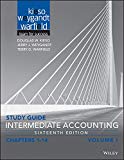
Introduction: Inventory includes raw materials, work-in-process goods and finished products which are held with the purpose of sale.
Case 1: T J International
Given: TJ International is a manufacturer of specialty building products. T J International’s adapted income statement and information concerning inventories from its annual report is provided in the question statement.
(a)
To determine how much would income before taxes have been if FIFO costing had been used to value all inventories.
(b)
To explain: To explain the income tax rate is 46.6%, what would income tax have been if FIFO costing had been used to value all inventories. In your opinion, is this difference in net income between the two methods material. Explain.
(c)
To explain: To explain the use of a different costing system for different types of inventory mean that there is a different physical flow of goods among the different types of inventory.
Case 2: N Pharmaceuticals, Inc.
Given: Description of N Pharmaceuticals has been provided in the question.
(a)
To explain: To explain what would you expect from the physical flow of goods for a pharmaceutical manufacturer to be like.
(b)
To state: To state the factors to be considered while selecting the inventory system.
(c)
To determine the reason for not including the amount of inventory used in stock of inventory.
Case 3: The K Company
Given: Data for K Company reported in its annual report, has been provided in the question.
(a)
To compute: To compute K’s inventory turnovers using:
(1) Cost of sales and LIFO inventory.
(2) Cost of sales and FIFO inventory.
(b)
To compute: To calculate turnover, using:
(1) Sales and LIFO inventory.
(2) Sales and FIFO inventory.
(c)
To state: To state which method you would choose to evaluate K’s performance. Justify your choice.
Learn your wayIncludes step-by-step video

Chapter 8 Solutions
Study Guide Intermediate Accounting, Volume 1: Chapters 1 - 14
- Chapter 20 Homework 19 1 points Exercise 20-17 (Algo) Preparation of cash budgets (for three periods) LO P2 Kayak Company budgeted the following cash receipts (excluding cash receipts from loans received) and cash payments (excluding cash payments for loan principal and interest payments) for the first three months of next year. Cash Receipts Cash payments eBook January February March $ 519,000 406,500 474,000 $ 463,600 351,100 524,000 Hint Ask Print References Mc Graw Hill Kayak requires a minimum cash balance of $40,000 at each month-end. Loans taken to meet this requirement charge 1%, interest per month, paid at each month-end. The interest is computed based on the beginning balance of the loan for the month. Any preliminary cash balance above $40,000 is used to repay loans at month-end. The company has a cash balance of $40,000 and a loan balance of $80,000 at January 1. Prepare monthly cash budgets for January, February, and March. Note: Negative balances and Loan repayment…arrow_forwardHow much is the accounts receivable turnover ratio?arrow_forwardIf the cost of the beginning work in process inventory is $92,000, costs of goods manufactured is $1,050,000, direct materials cost is $375,000, direct labor cost is $255,000, and overhead cost is $360,000, calculate the ending work in process inventory. a. $158,000 b. $32,000 c. $45,000 d. $12,000arrow_forward
- PUG Company's revenue for March is $75,000, but only $15,000 cash is collected. Expenses for March are $41,000, of which $28,000 is paid in cash. During March, additional capital stock is issued in exchange for $5,000 cash. Using the accrual basis of accounting, what would PUG Company’s income statement for March report?arrow_forwardDo fast answer of this general accounting questionarrow_forward??!arrow_forward

 AccountingAccountingISBN:9781337272094Author:WARREN, Carl S., Reeve, James M., Duchac, Jonathan E.Publisher:Cengage Learning,
AccountingAccountingISBN:9781337272094Author:WARREN, Carl S., Reeve, James M., Duchac, Jonathan E.Publisher:Cengage Learning, Accounting Information SystemsAccountingISBN:9781337619202Author:Hall, James A.Publisher:Cengage Learning,
Accounting Information SystemsAccountingISBN:9781337619202Author:Hall, James A.Publisher:Cengage Learning, Horngren's Cost Accounting: A Managerial Emphasis...AccountingISBN:9780134475585Author:Srikant M. Datar, Madhav V. RajanPublisher:PEARSON
Horngren's Cost Accounting: A Managerial Emphasis...AccountingISBN:9780134475585Author:Srikant M. Datar, Madhav V. RajanPublisher:PEARSON Intermediate AccountingAccountingISBN:9781259722660Author:J. David Spiceland, Mark W. Nelson, Wayne M ThomasPublisher:McGraw-Hill Education
Intermediate AccountingAccountingISBN:9781259722660Author:J. David Spiceland, Mark W. Nelson, Wayne M ThomasPublisher:McGraw-Hill Education Financial and Managerial AccountingAccountingISBN:9781259726705Author:John J Wild, Ken W. Shaw, Barbara Chiappetta Fundamental Accounting PrinciplesPublisher:McGraw-Hill Education
Financial and Managerial AccountingAccountingISBN:9781259726705Author:John J Wild, Ken W. Shaw, Barbara Chiappetta Fundamental Accounting PrinciplesPublisher:McGraw-Hill Education





